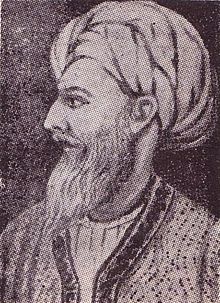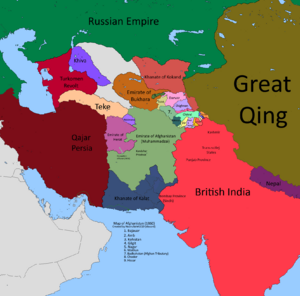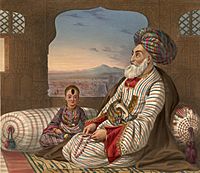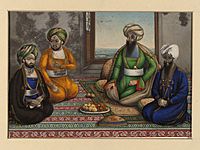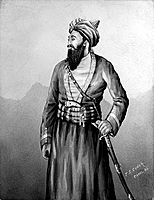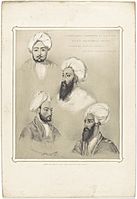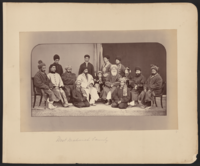Dost Mohammad Khan facts for kids
Quick facts for kids Dost Mohammad Khanدوست محمد خان |
|||||
|---|---|---|---|---|---|
| Amir al-Mu'minin Amir-I-Kabir The Great Amir |
|||||
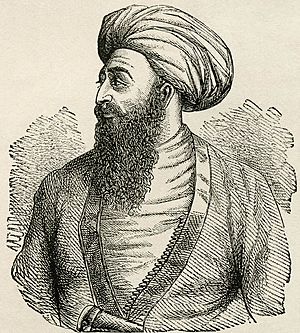 |
|||||
| Emir of Afghanistan | |||||
| Reign | Summer 1826 – 2 August 1839 1843 – 9 June 1863 |
||||
| Predecessor | Sultan Mohammad Khan | ||||
| Successor | Wazir Akbar Khan Sher Ali Khan |
||||
| Born | 23 December 1792 Kandahar, Durrani Empire |
||||
| Died | 9 June 1863 (aged 70) Herat, Emirate of Afghanistan |
||||
| Burial | Shrine of Khwaja Abd Allah (Gazur Gah), Herat, Afghanistan | ||||
| Spouse | 16 wives | ||||
| Issue | 27 sons and 25 daughters at the time of his death | ||||
|
|||||
| Dynasty | Barakzai dynasty | ||||
| Father | Sardar Payinda Khan Mohammadzai (Sarfraz Khan) | ||||
| Mother | Zainab Begum | ||||
| Religion | Sunni Islam | ||||
| Military career | |||||
| Battles/wars |
|
||||
Emir Dost Mohammad Khan Barakzai (born 23 December 1792, died 9 June 1863) was a very important ruler in Afghanistan. He was known as the Amir-i Kabir, which means "The Great Amir." He started the Barakzai dynasty and led Afghanistan during the First Anglo-Afghan War.
He became the leader, or Emir, of Afghanistan in 1826. This happened after the previous ruling family, the Durrani dynasty, became weaker. Dost Mohammad Khan was the 11th son of Payendah Khan, who was a chief of the Barakzai Pashtun people.
Early in his rule, Afghanistan lost the Peshawar Valley to the Sikh Khalsa Army in 1823. But by the end of his time as Emir, he had brought back together important areas like Kandahar and Herat with Kabul. Dost Mohammad Khan ruled for a very long time, about 36 years.
Contents
Becoming a Leader
Dost Mohammad Khan was born into a powerful family in Kandahar on December 23, 1792. His father, Payinda Khan, was a chief of the Barakzai Tribe and worked for the Durrani Empire. Their family had a long history in the region. Dost Mohammad Khan's mother was from the Qizilbash group. He spoke several languages, including Persian, Pashto, Punjabi, and Turkish.
His older brother, Fateh Khan, helped Mahmud Shah Durrani become the ruler of Afghanistan. Dost Mohammad joined his brother in a battle against the Sikhs at Attock. However, Mahmud Shah later had Fateh Khan killed in 1818. This made Fateh Khan's family very angry.
After a lot of fighting, Mahmud Shah lost most of his lands. Fateh Khan's brothers divided the lands among themselves. Dost Mohammad received Ghazni, and in 1826, he also gained control of Kabul, which was the richest part of Afghanistan. When he first became ruler, his government earned about 500,000 rupees. By the 1830s, this amount grew to 2.5 million rupees, showing how well he managed things.
From the start of his rule, Dost Mohammad had problems with Ranjit Singh, the Sikh ruler of the Punjab region. Ranjit Singh supported a former Afghan prince, Shah Shujah Durrani, to try and take back the kingdom. In 1834, Shah Shujah tried to regain his throne. Dost Mohammad Khan led his forces, first in the Jalalabad campaign, and then marched to Kandahar. Shah Shujah was defeated there by Dost Mohammad Khan's forces.
While this was happening, Ranjit Singh took the chance to take over Peshawar. Peshawar had been ruled by Dost Mohammad's brother, Sultan Mohammad Khan. Dost Mohammad sent his son, Wazir Akbar Khan, to fight the Sikhs at the Battle of Jamrud in 1837. But they could not take back the Jamrud Fort, which was a big worry for the Afghan Emir.
Afghanistan and Europe
Afghanistan was located between the powerful British and Russian empires. This meant Dost Mohammad Khan had to be very careful with his political choices. He tried to make friends with Great Britain and welcomed Alexander Burnes, a British visitor, to Kabul in 1837.
However, the British governor-general, Lord Auckland, did not agree to Dost Mohammad's requests. The British wanted him to give up trying to get Peshawar back and let them guide his foreign policy. When Dost Mohammad refused and started talking to Russia again, Lord Auckland sent British troops to fight him in 1838. The British even created reasons to justify removing the Afghan ruler.
Fighting the Sikhs
In 1835, Dost Mohammad Khan, who had become the Emir of Kabul, moved his forces towards the Khyber Pass. He wanted to get Peshawar back. In 1836, Hari Singh Nalwa, a Sikh general, built forts to protect the pass, including one at Jamrud. Dost Mohammad built a fort at Ali Masjid on the other side.
In early 1837, Dost Mohammad Khan sent a large force of 25,000 men with heavy guns to attack Jamrud. The Sikh fort had only 600 men and a few small cannons. The Afghans surrounded the fort and cut off its water. The Sikh commander, Mahan Singh Mirpuri, held them off for four days and sent for help. Hari Singh Nalwa, though sick, rushed to Jamrud.
In the final battle on April 30, 1837, the Afghans retreated after Hari Singh Nalwa was killed. In 1838, with the help of the Sikh ruler and the British, Shah Shuja Durrani was put back on the Afghan throne in Kabul on August 7, 1839.
Dost Mohammad Khan was sent away by the British to Mussoorie in November 1840. But he was brought back to his position after Shah Shuja was killed in April 1842. After this, he kept good relations with the Sikh kingdom.
Second Time as Ruler
After the First Anglo-Afghan War ended in 1842, Dost Mohammad Khan was able to make his country much bigger. This was partly because his relationship with the British improved. During his time away in Calcutta, he was treated well.
He saw how advanced the British were in technology. He realized that fighting them all the time would hurt Afghanistan. Instead, he believed that an alliance with the British was the best way for Afghanistan to survive. When the British fought and defeated the Sikh Empire in the First and Second Anglo-Sikh Wars, it removed a threat to Afghanistan. This allowed Dost Mohammad Khan to expand his kingdom with British help, as they both had similar goals in Central Asia.
In 1843, Dost Mohammad Khan brought the Hazarajat region (including Behsud, Dai Zangi, Dai Kundi) and Bamian back under his control. These areas had become independent during the British invasion. In 1846, a rebellion by the Kohistani Tajiks in Tagab was stopped, and Dost Mohammad made his control stronger there. In July 1848, he planned to conquer Balkh, but the Second Anglo-Sikh War delayed him. The Sikhs offered to give Peshawar to the Afghans (though it never happened). So, Mohammad sent 5,000 Afghans to help the Sikhs in the war.
When the Sikhs were defeated, the British took back Peshawar. People in Kabul worried the British would then invade Afghanistan. But this did not happen. So, Dost Mohammad sent his son, Mohammad Akram Khan, to invade Balkh in the spring of 1849.
Taking Over Balkh
The invasion of Balkh was successful, and the area became part of Afghanistan. Later, Afzal Khan used materials from the old city of Balkh to build a new military camp called Takhtapul. By 1854, Takhtapul had grown into a full city with gardens and courts. In 1850, Mohammad Akram Khan's half-brother, Ghulam Haidar Khan, conquered Tashqurghan.
Working with the British
On March 30, 1855, Dost Mohammad changed his previous policy. He made an alliance with the British government, agreeing to help each other if attacked. This agreement was signed by Sir Henry Lawrence. In November 1855, he conquered Kandahar. In 1857, he declared war on Persia with the British. A treaty was made in July that put the province of Herat under a Barakzai prince. During the Indian Rebellion of 1857, Dost Mohammad chose not to help the rebels. His later years had some problems in Herat and Bukhara.
Capturing Herat and His Death
In March 1862, Ahmad Khan, the ruler of Herat, captured Farah. This area had been controlled by the Barakzai Emirs since 1856. This gave Dost Mohammad Khan a reason to attack Herat. On June 29 or July 8, Farah was captured by Dost Mohammad's forces. On July 22, Sabzawar was also captured. By July 28, Herat was under siege.
After a 10-month siege, he finally captured Herat on May 27, 1863. But on June 9, he suddenly died in the middle of this victory. He had played a huge role in the history of South and Central Asia for forty years. He named his son, Sher Ali Khan, as the next ruler. He was buried in Herat at the Gazurgah. By the time he died, his government's yearly income had grown to 7 million rupees.
Gallery
-
Khan as Emir of Afghanistan.
-
Dōst Moḥammad Khan seated slightly to the right of center in this photograph. To Dōst Moḥammad's right, the first figure in a white chapan (overcoat) is his son and successor Sher ʻAlī Khān (1825–1879), who ruled Afghanistan from 1863 to 1879. Abd al-Raḥmān Khān (c. 1844 – 1901), the grandson of Dōst Mohammad and future “Iron Amir” of Afghanistan, is on Dōst Moḥammad's far left.
See also
- List of leaders of Afghanistan


